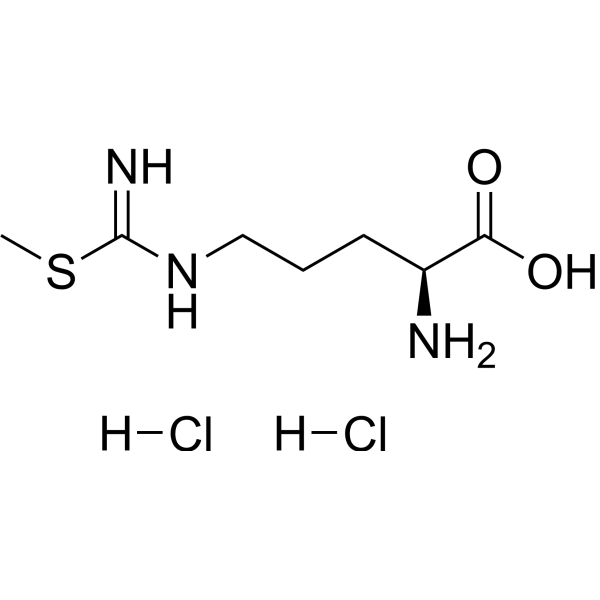产品
编 号:F259314
分子式:C7H17Cl2N3O2S
分子量:278.2
分子式:C7H17Cl2N3O2S
分子量:278.2
产品类型
规格
价格
是否有货
结构图

CAS No: 209589-59-3
产品详情
生物活性:
S-MTC (S-Methyl-L-thiocitrulline) dihydrochloride is a selective type I nitric oxide synthase (NOS) inhibitor.
体内研究:
S-MTC dihydrochloride (S-methyl-L-thiocitrulline) is a selective neuronal NOS-inhibitor. Following pretreatment with S-MTC dihydrochloride (i.c.v.), the HBO2-induced antinociception is significantly antagonized. In Experiment #2, different groups of mice are pretreated with naltrexone hydrochloride (NTX) (3.0 mg/kg, i.p.), L-NAME (1.0 μg/mouse, i.c.v.), S-MTC dihydrochloride (1.0 μg/mouse, i.c.v.) or N5-(1-iminoethyl)-L-ornithine (L-NIO) (3.0 mg/kg, s.c.) 15-30 min prior to HBO2 treatment. The antinociceptive effect assessed 90 min after HBO2 treatment is completely abolished by NTX and L-NAME, antagonized by two-thirds by S-MTC dihydrochloride and largely unaffected by L-NIO (F=25.57, p<0.0001). At a dose of 0.3 mg/kg, S-MTC dihydrochloride (SMTC) causes a rise in meanblood pressure (BP). At doses of 1.0, 3.0 and 10 mg/kg, S-MTC dihydrochloride causes falls in heart rate, rises in BP and vasoconstriction in all three vascular beds.
体外研究:
S-MTC dihydrochloride (10 or 100?μM) reduces cellular NO release in the absence of Aβ1-42. At 100?μM, S-MTC dihydrochloride decreases cell viability. S-MTC dihydrochloride (100?μM) significantly lowers nitrite production (11.2±1.1?μM) when compared to control (no NOS inhibitor exposure; 19.6±1.2?μM). Nitrite productions after Aβ1-42 and L-NOARG (100?μM) or Aβ1-42 and S-MTC dihydrochloride (100?μM) treatments are significantly lower than Aβ1-42 alone (33.5±2.0 and 34.5±1.6?μM, respectively). S-MTC dihydrochloride (100?μM)is able to significantly reduce nitrite production (25.2±1.1?μM) as compared to Aβ1-42 treatment alone (38.3±2.7?μM), when administered after Aβ1-42 at the 1?h time point.S-MTC dihydrochloride (100?μM) concentration decreases both MTT (87±1% of control) and NR (80±1% of control, respectively) levels. The co-administration of S-MTC dihydrochloride (100?μM) and Aβ1-42 significantly reverses the effects of Aβ1-42 alone (72±2% vs 61±2% of control).
S-MTC (S-Methyl-L-thiocitrulline) dihydrochloride is a selective type I nitric oxide synthase (NOS) inhibitor.
体内研究:
S-MTC dihydrochloride (S-methyl-L-thiocitrulline) is a selective neuronal NOS-inhibitor. Following pretreatment with S-MTC dihydrochloride (i.c.v.), the HBO2-induced antinociception is significantly antagonized. In Experiment #2, different groups of mice are pretreated with naltrexone hydrochloride (NTX) (3.0 mg/kg, i.p.), L-NAME (1.0 μg/mouse, i.c.v.), S-MTC dihydrochloride (1.0 μg/mouse, i.c.v.) or N5-(1-iminoethyl)-L-ornithine (L-NIO) (3.0 mg/kg, s.c.) 15-30 min prior to HBO2 treatment. The antinociceptive effect assessed 90 min after HBO2 treatment is completely abolished by NTX and L-NAME, antagonized by two-thirds by S-MTC dihydrochloride and largely unaffected by L-NIO (F=25.57, p<0.0001). At a dose of 0.3 mg/kg, S-MTC dihydrochloride (SMTC) causes a rise in meanblood pressure (BP). At doses of 1.0, 3.0 and 10 mg/kg, S-MTC dihydrochloride causes falls in heart rate, rises in BP and vasoconstriction in all three vascular beds.
体外研究:
S-MTC dihydrochloride (10 or 100?μM) reduces cellular NO release in the absence of Aβ1-42. At 100?μM, S-MTC dihydrochloride decreases cell viability. S-MTC dihydrochloride (100?μM) significantly lowers nitrite production (11.2±1.1?μM) when compared to control (no NOS inhibitor exposure; 19.6±1.2?μM). Nitrite productions after Aβ1-42 and L-NOARG (100?μM) or Aβ1-42 and S-MTC dihydrochloride (100?μM) treatments are significantly lower than Aβ1-42 alone (33.5±2.0 and 34.5±1.6?μM, respectively). S-MTC dihydrochloride (100?μM)is able to significantly reduce nitrite production (25.2±1.1?μM) as compared to Aβ1-42 treatment alone (38.3±2.7?μM), when administered after Aβ1-42 at the 1?h time point.S-MTC dihydrochloride (100?μM) concentration decreases both MTT (87±1% of control) and NR (80±1% of control, respectively) levels. The co-administration of S-MTC dihydrochloride (100?μM) and Aβ1-42 significantly reverses the effects of Aβ1-42 alone (72±2% vs 61±2% of control).
产品资料

